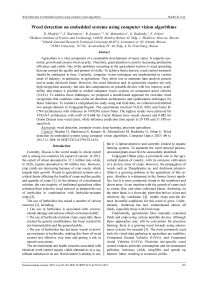Weed detection on embedded systems using computer vision algorithms
Автор: Shadrin D., Illarionova S., Kasatov R., Akimenkova M., Rudensky G., Erhan E.
Журнал: Компьютерная оптика @computer-optics
Рубрика: Обработка изображений, распознавание образов
Статья в выпуске: 1 т.49, 2025 года.
Бесплатный доступ
Agriculture is a vital component of a sustainable development of many states. It supports economic growth and ensures food security. Therefore, great attention is paid to increasing production efficiency and yields. One of the problems occurring in the agricultural section is weed spreading that can corrupt the quality and amount of yields. To achieve better harvest, weed control measures should be conducted in time. Currently, computer vision techniques are implemented in various areas of industry, in particular, in agriculture. They allow one to automate data analysis process and to make decisions faster. However, the weed detection task in agriculture requires not only high recognition accuracy, but also fast computations on portable devices with low memory availability that makes it possible to embed computer vision systems on unmanned aerial vehicles (UAVs). To address these challenges, we proposed a neural-based approach for real-time weed recognition that combines state-of-the-art detection architectures and optimization techniques for faster inference. To conduct a comprehensive study using real field data, we collected and labelled two unique datasets in Volgograd Region. The experiments involved YOLO, SSD, and Faster R-CNN architectures with inference on NVIDIA Jetson Nano. The highest results were achieved for YOLOv5 architecture with mAP of 0.668 for Carrot Dataset (two weeds classes) and 0.882 for Onion Dataset (one weed class), while inference prediction time equals to 29 FPS and 31 FPS respectively.
Weed detection, computer vision, deep learning, precision agriculture
Короткий адрес: https://sciup.org/140310447
IDR: 140310447 | DOI: 10.18287/2412-6179-CO-1454


